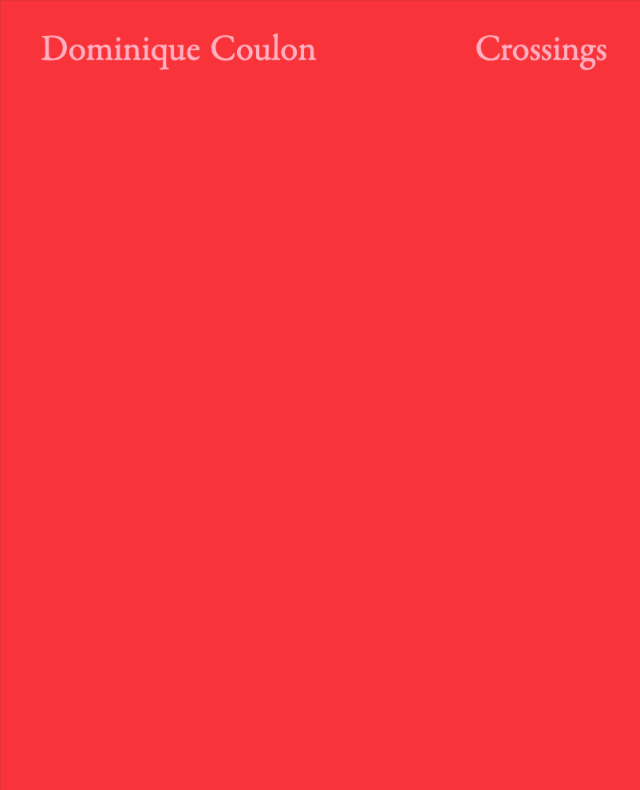Crossings
Crossings: Dominique Coulon & Associés
Dominique Coulon
Actar Publishers, January 2021
Hardcover | 9-1/4 x 11-1/2 inches | 352 pages | English | ISBN: 978-1948765312 | $59.95
PUBLISHER'S DESCRIPTION:
REFERRAL LINKS:
Dominique Coulon
Actar Publishers, January 2021
Hardcover | 9-1/4 x 11-1/2 inches | 352 pages | English | ISBN: 978-1948765312 | $59.95
PUBLISHER'S DESCRIPTION:
The writing of Dominique Coulon & Associés, nominated twice for the Mies van der Rohe award, reflects the agency’s work in connection with different contextual postures and the construction of complex spatial relationships.
In circumstances that are often difficult, buildings add value to their locations, transforming them. This book explores the public dimension of architecture taking a new look at the eclectic work of Dominique Coulon; his production of public buildings illustrates the complexity of his architectural approach. Dominique Coulon plays with context, light, and materiality to produce public places that are detailed and welcoming. The areas he proposes affect and accompany the body. His architecture is part of a dynamic relationship, mobilising the senses to propose a specific universe, which may be cheerful, or dramatic. These spaces serve the public dimension of his architecture.
Dominique Coulon was born in the Jura region of eastern France in 1961 and studied architecture in Strasbourg and Paris-Belleville. After graduating in 1989, he set up his office in Strasbourg, in eastern France. In 1991, he won the Villa Medici Hors les Murs award and travelled in the United States, Latin America and Europe.
REFERRAL LINKS:
One of the most interesting projects in the 25-plus-year career of French architect Dominique Coulon is not included in Crossings, the new monograph on his eponymous firm. It is the six-story building in Strasbourg that houses the office of Dominique Coulon & Associés as well as the architect's own home. The two programs interlock, with the office basically downstairs and the apartment upstairs; a scissor stair separated by wire mesh creates distinct, yet visually connected work and living routes up and down the building. Architect Luca Merlini, in one of the four conversations inserted into the book on pink pages (second spread, below), asks Coulon why he didn't include the building in the book. His reply: "It's not an oversight — it's more of a choice. The agency works almost exclusively on public buildings — it's the collective dimension that interests us. So including this project in the book would have been rather out of place."
With multiple schools, libraries, sports complexes, and theaters, among other public functions, I can't help but agree with Coulon. Nevertheless, I'm glad Merlini asks the question, in turn drawing readers' attentions to the architect's wider oeuvre as well as his influences and ways of designing and thinking. At first I found the 65-page "Conversations" section a bit odd: it's a lot of text, and considering how little most architects actually read, I couldn't help think the conversations might have worked better if they were spread out evenly among the eighteen completed buildings rather than in one chunk. But by talking with a fellow architect (Merlini), a neuroscientist (Claude Bonnet) a client (Étienne Butzbach), and two philosophers (Daniel Payot and Alexandra Pignol), the four conversations held more interest than I was expecting. Too many monographs feature interviews that are more marketing than insightful, but these are the opposite; they are intellectual and truly conversations, with readers learning just as much about the guests of Coulon as they do about Coulon himself.
Still, the meat of any monograph is its projects, and those in Crossings are very good and documented very well. Logically, the standouts for this book blogger are two of the libraries: Thionville (third spread) and Pélisanne. As it happens, each of these buildings features curving glass walls, which make them stand out visually from the orthogonal and diagonal compositions that make up the most of the two decades of buildings on display here. The curving walls of Thionville combine with snaking furniture and amorphous cubbies to make the library look like an inviting place for children to spend time in — not an easy feat these days. Pélisanne, the last project in the book, has just one curved wall: a concave wall that defers to a large tree in front of the existing building it is attached to. On the lower level, the curved wall is fitted with bookcases, while upstairs it is all-glass, with chairs letting patrons sit with a book beneath the tree's impressive canopy. These are two excellent buildings in an excellent portfolio in an excellent monograph.









